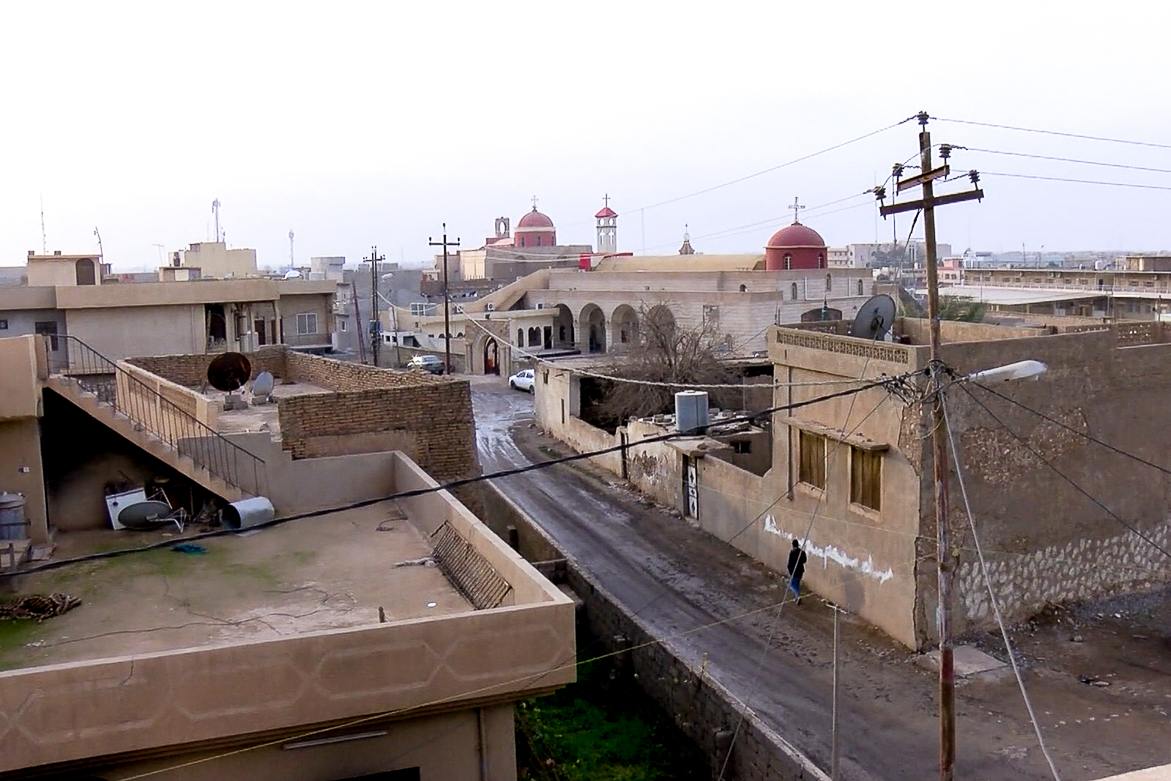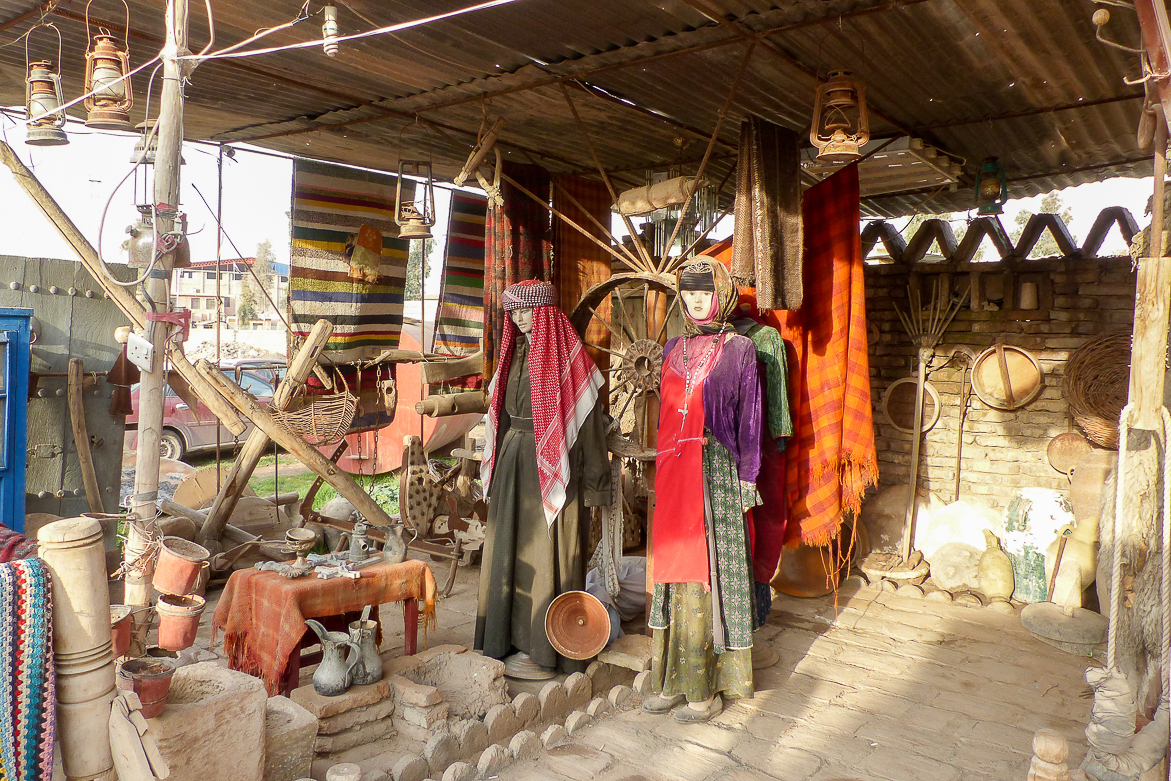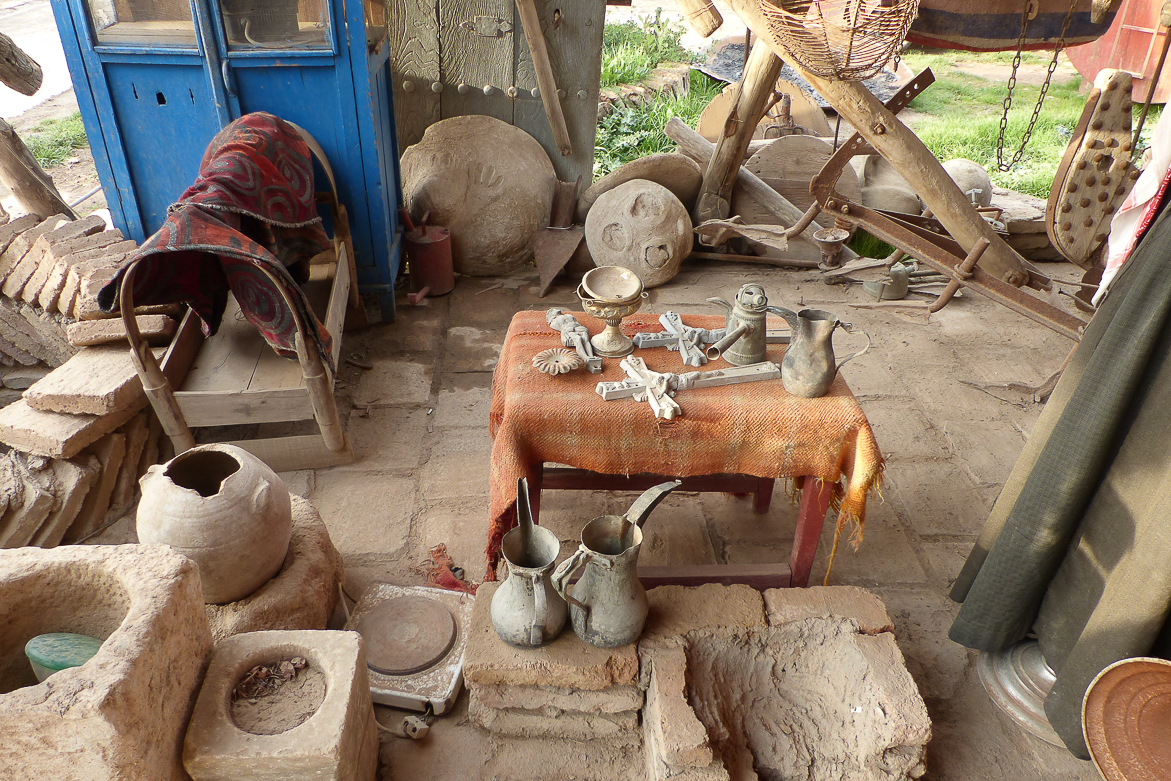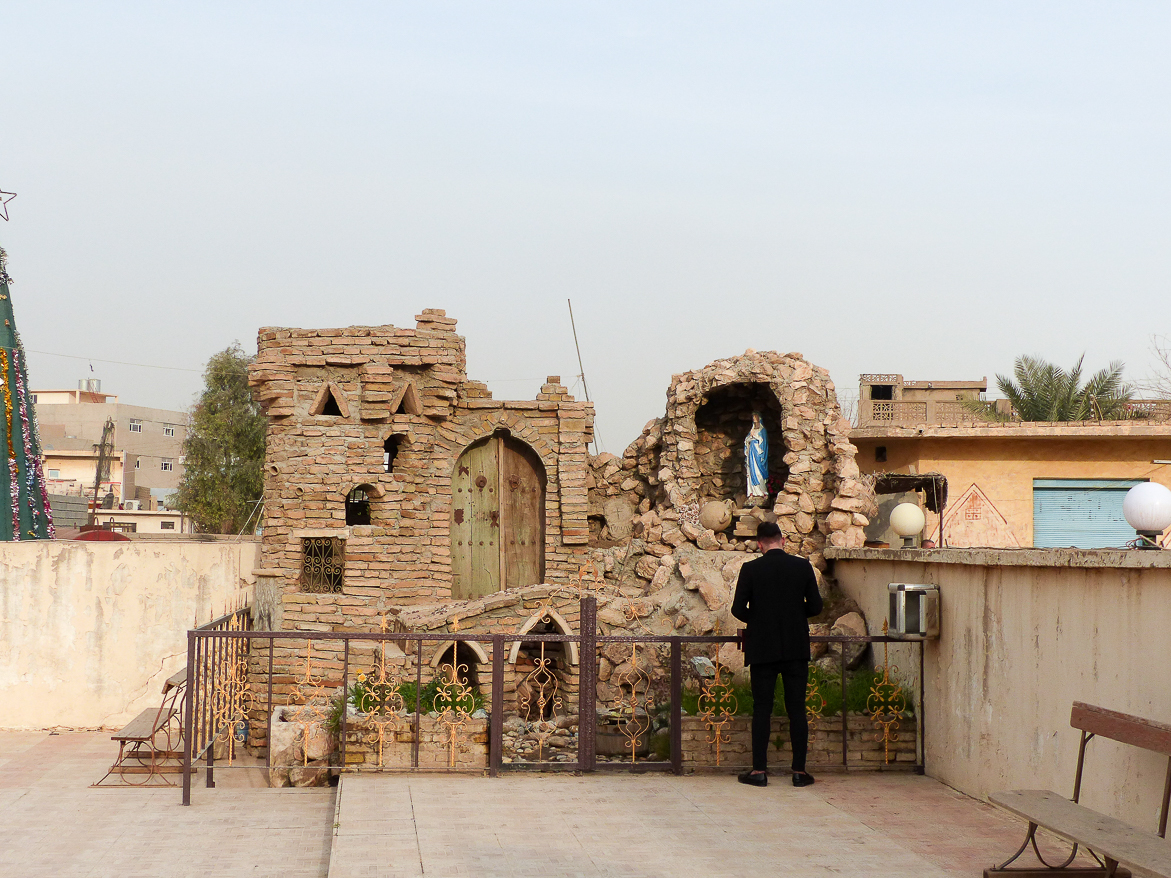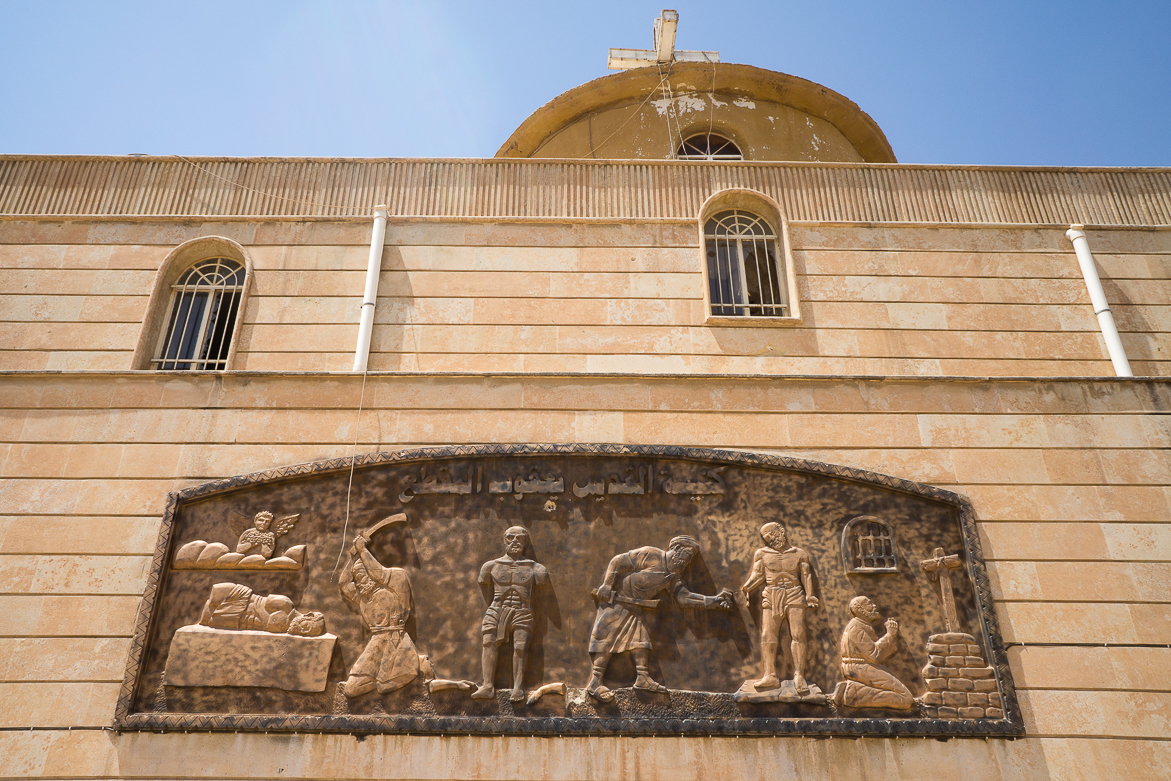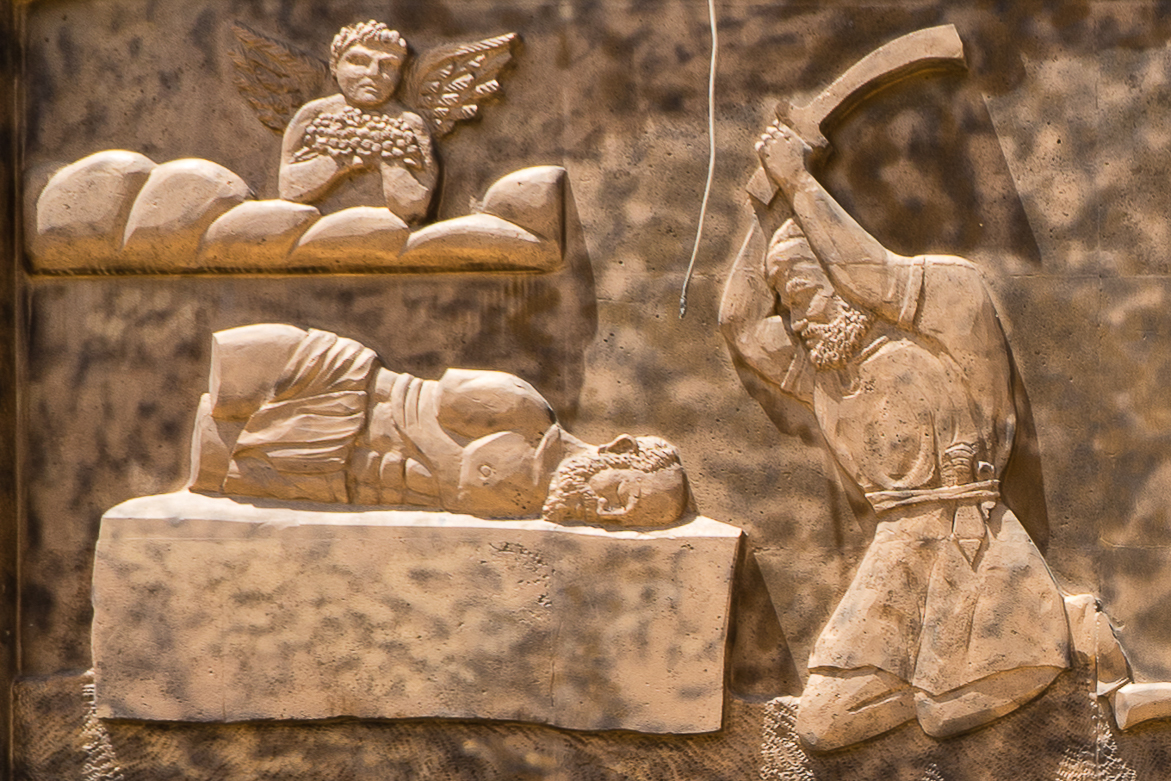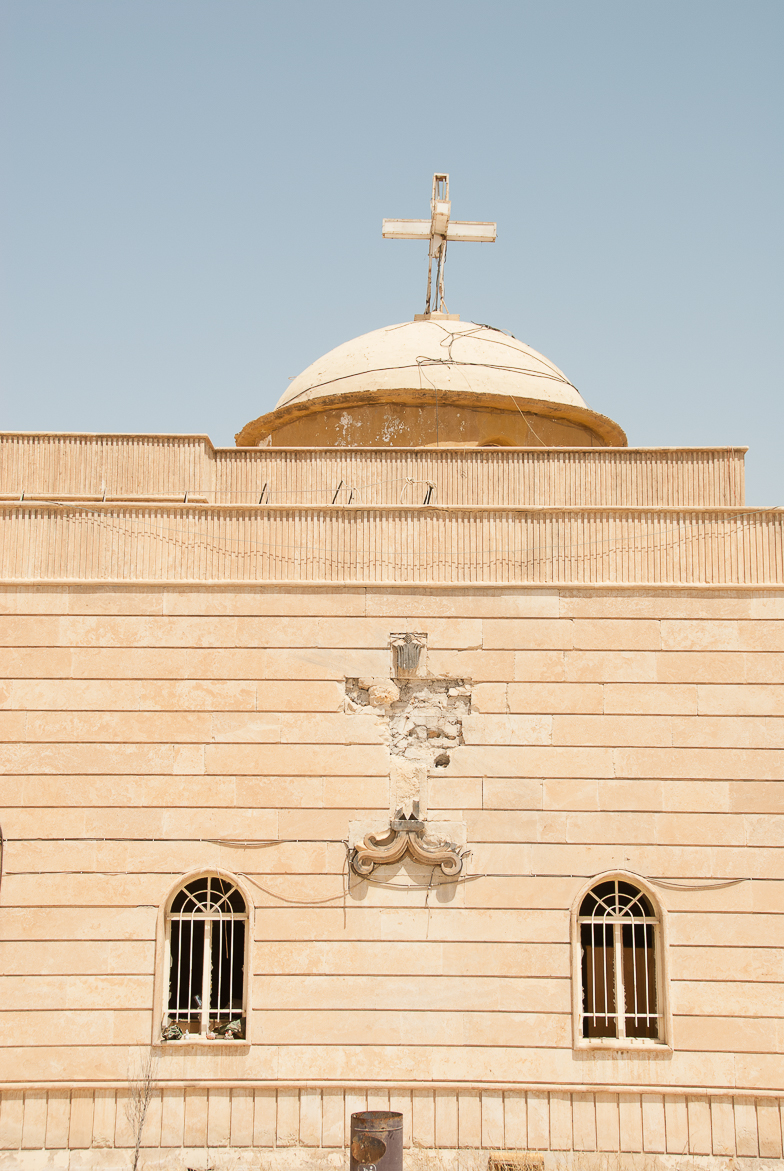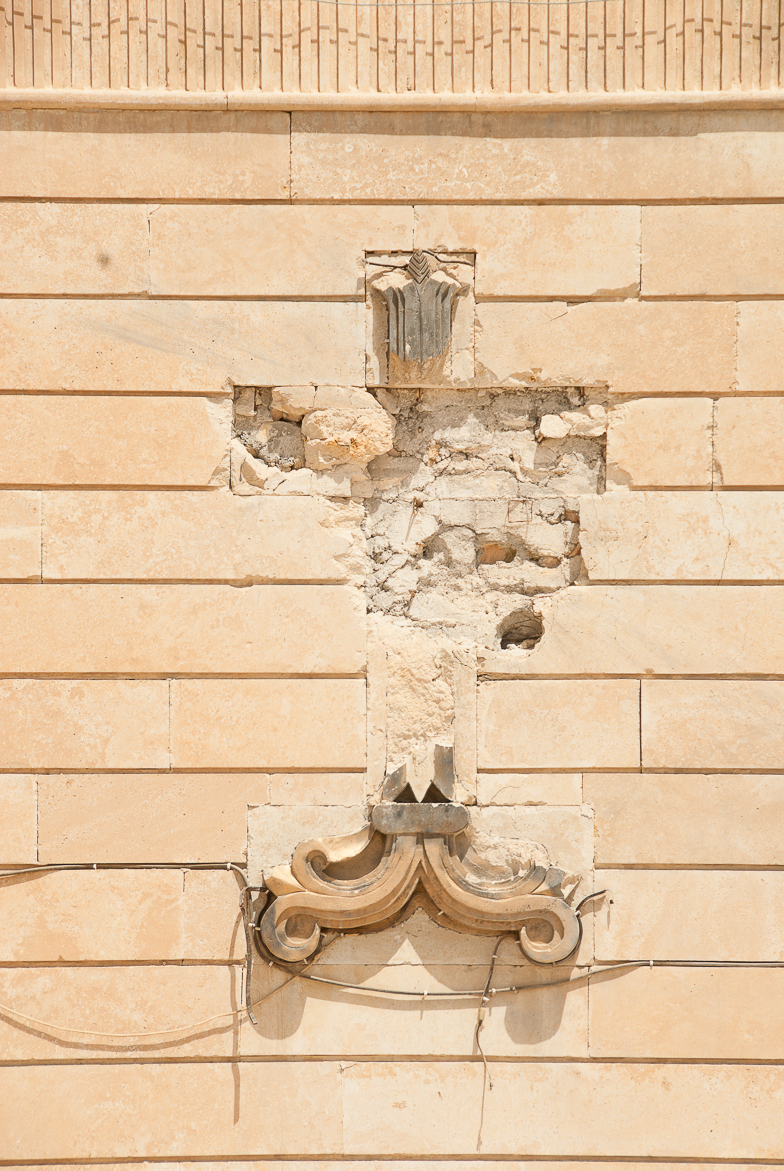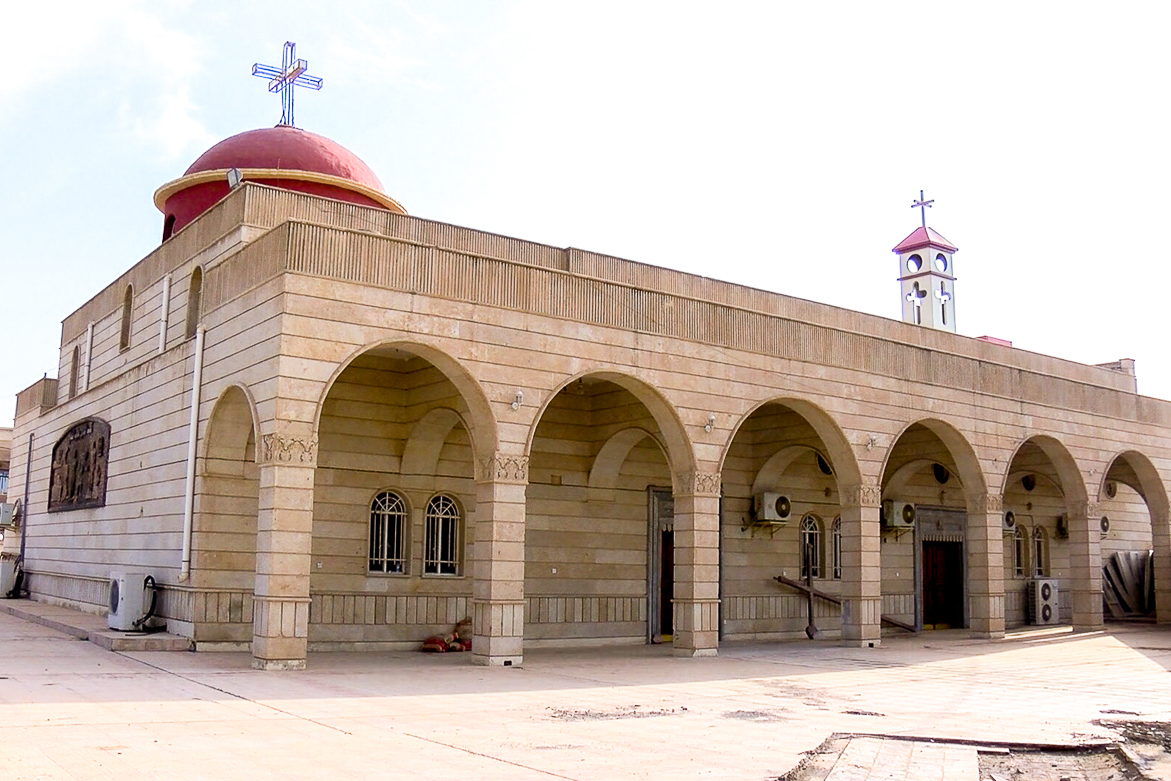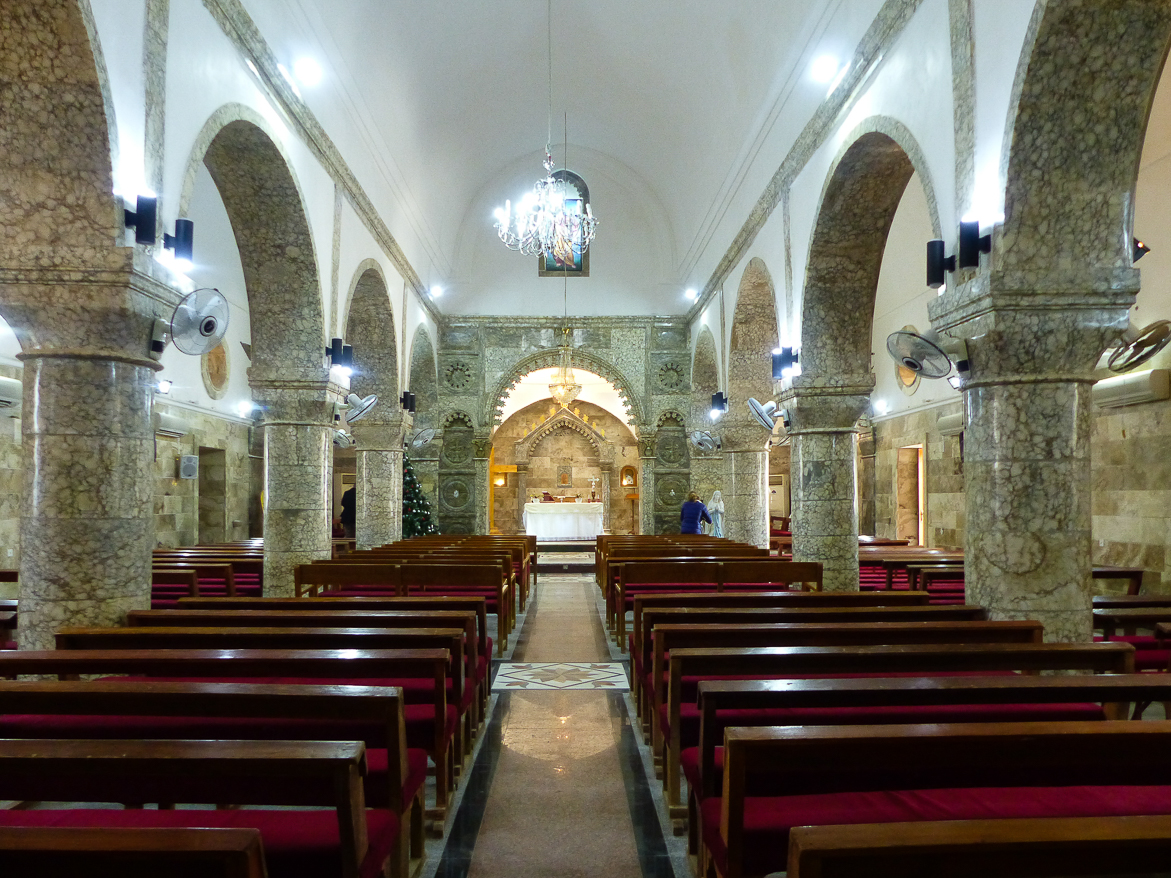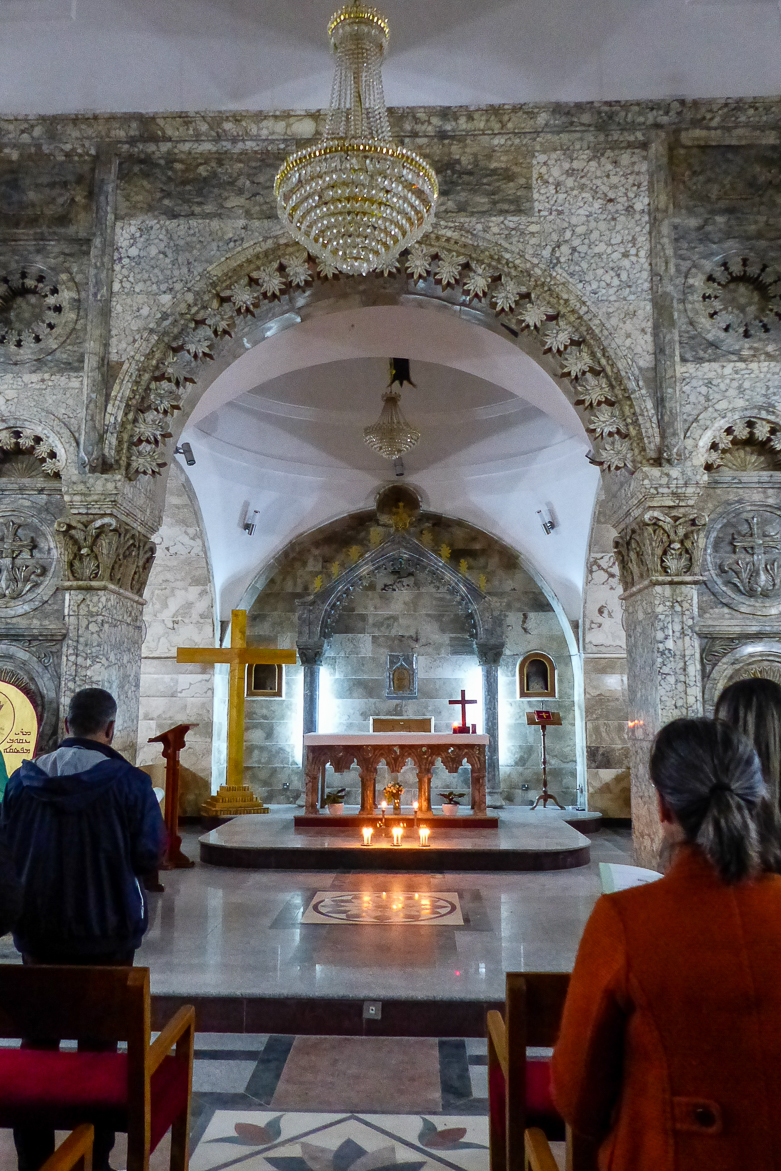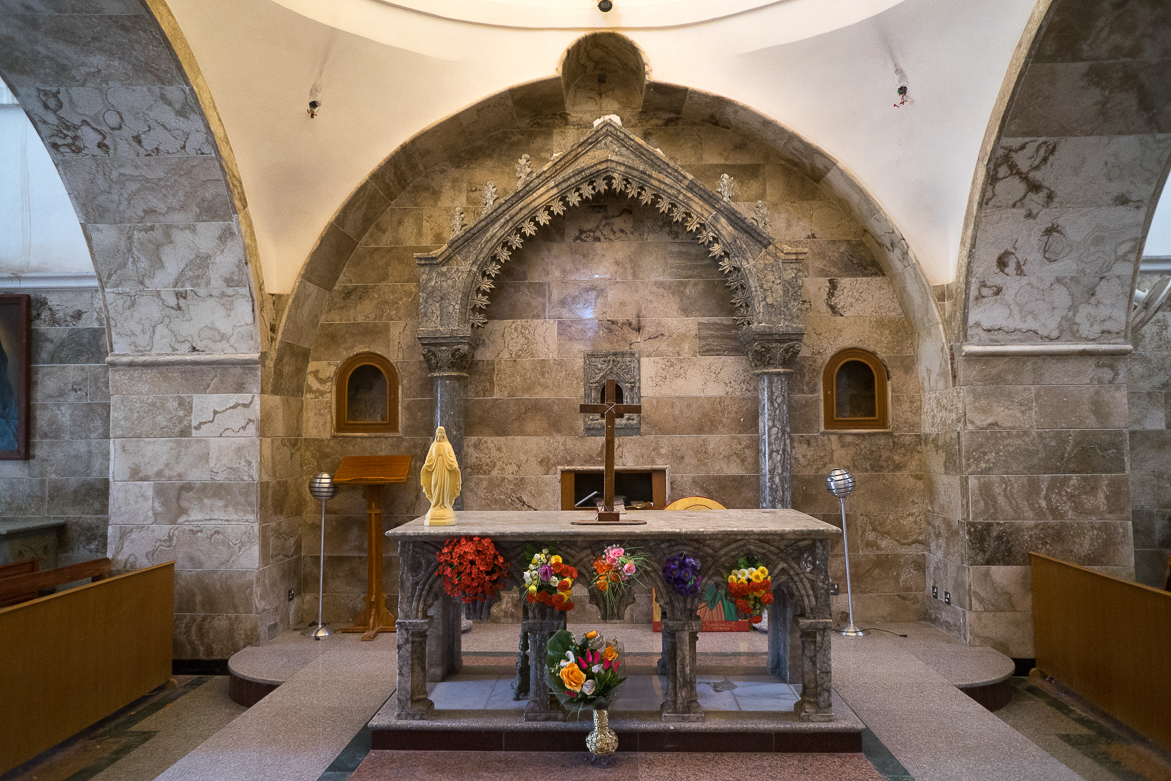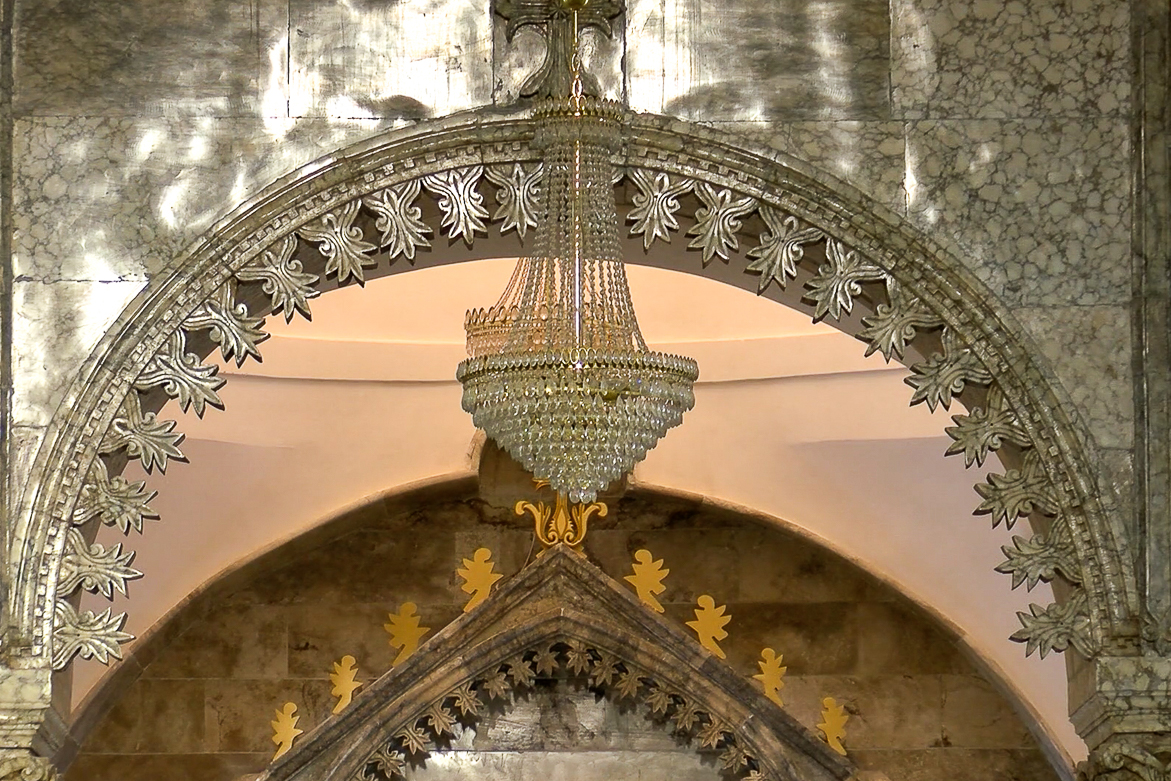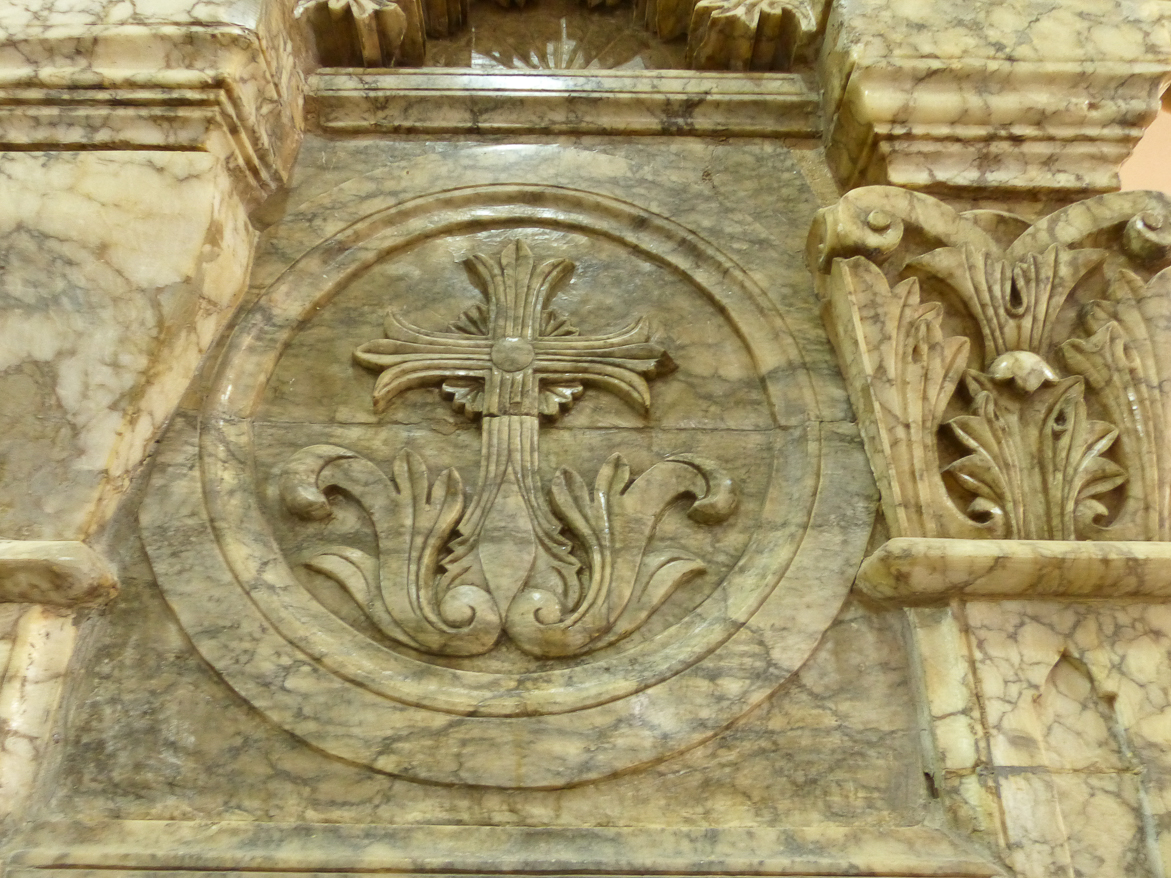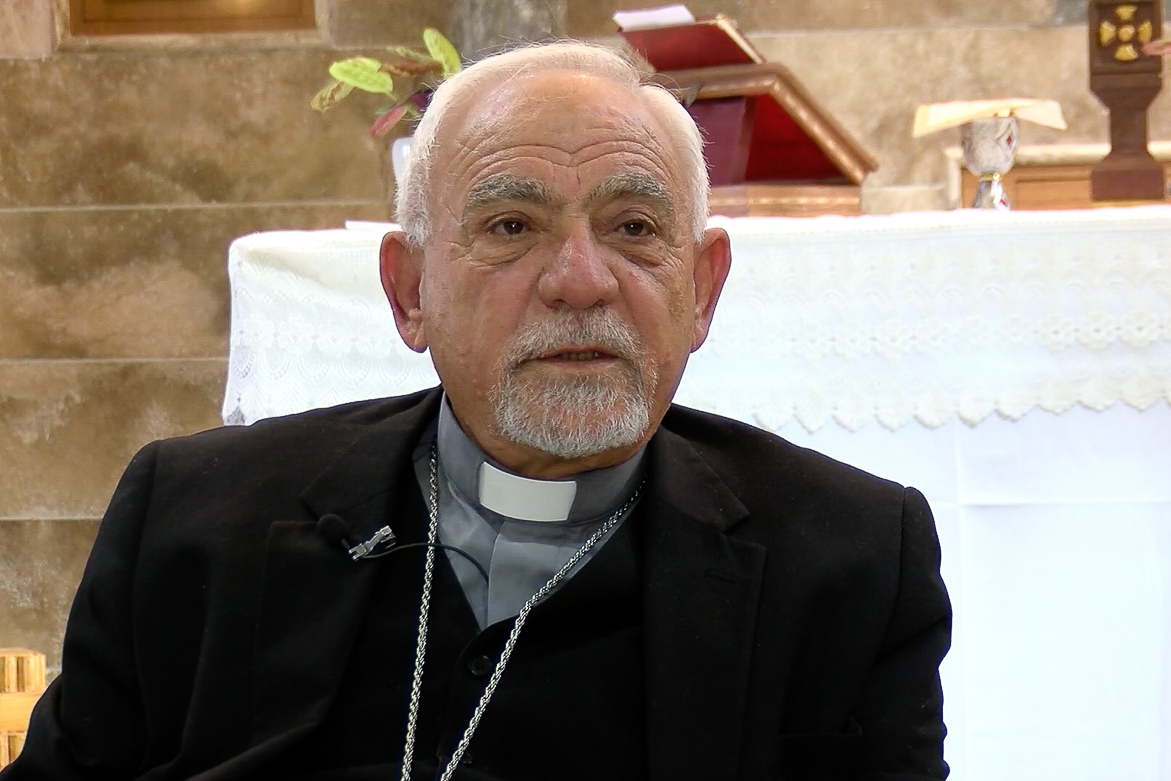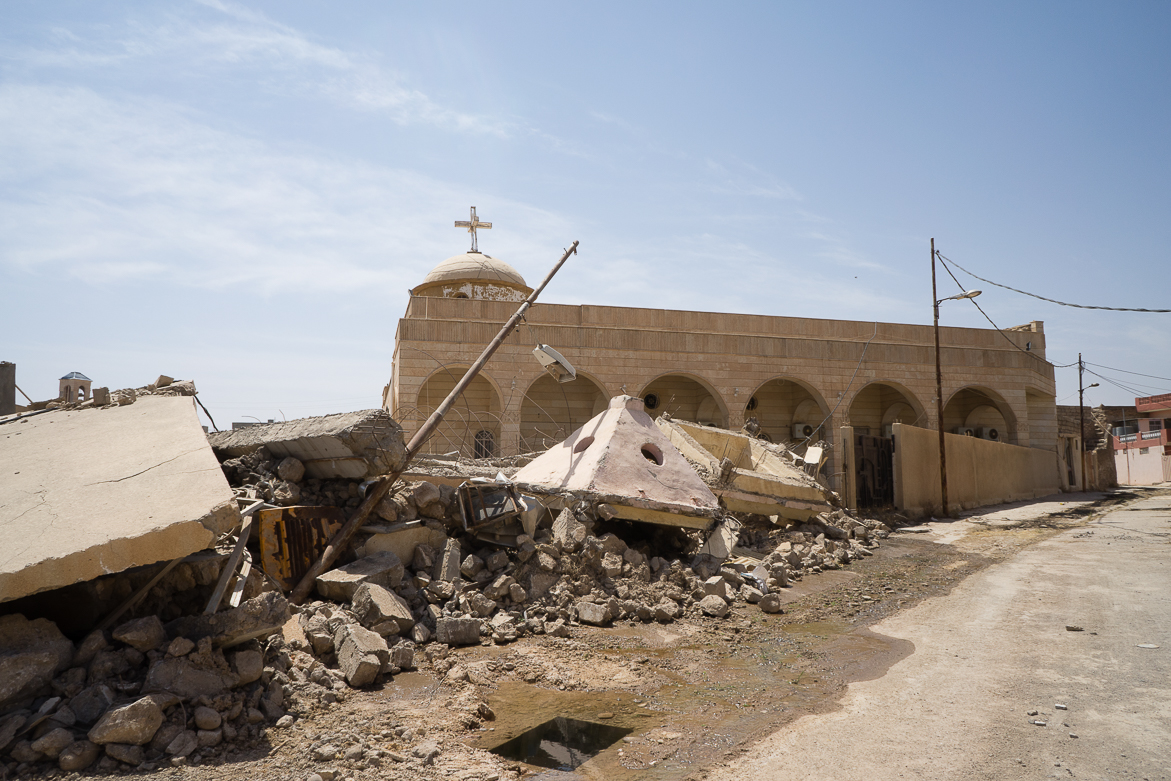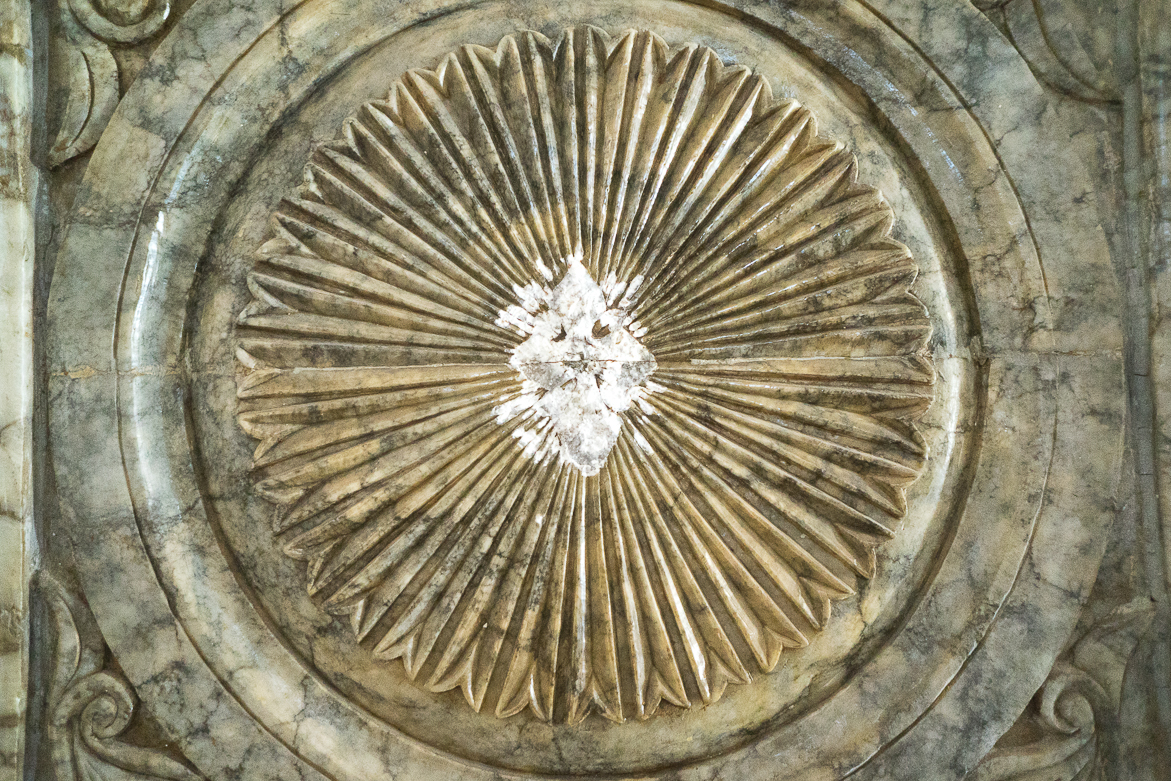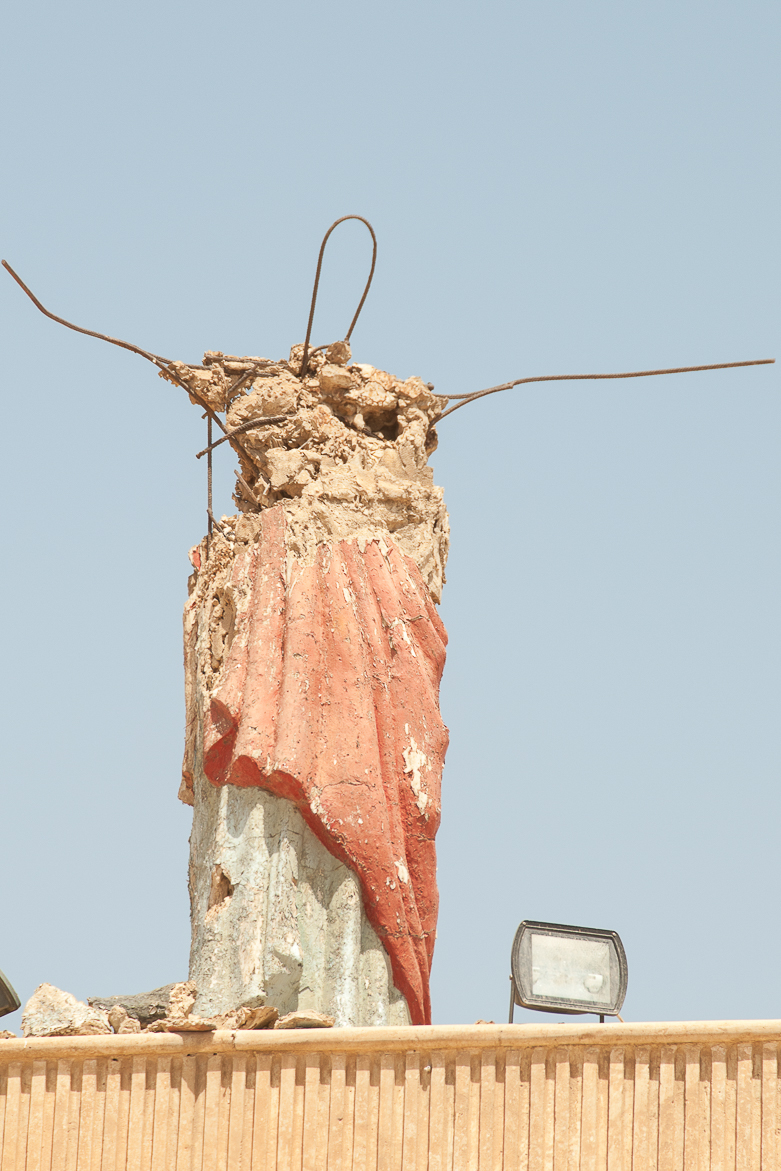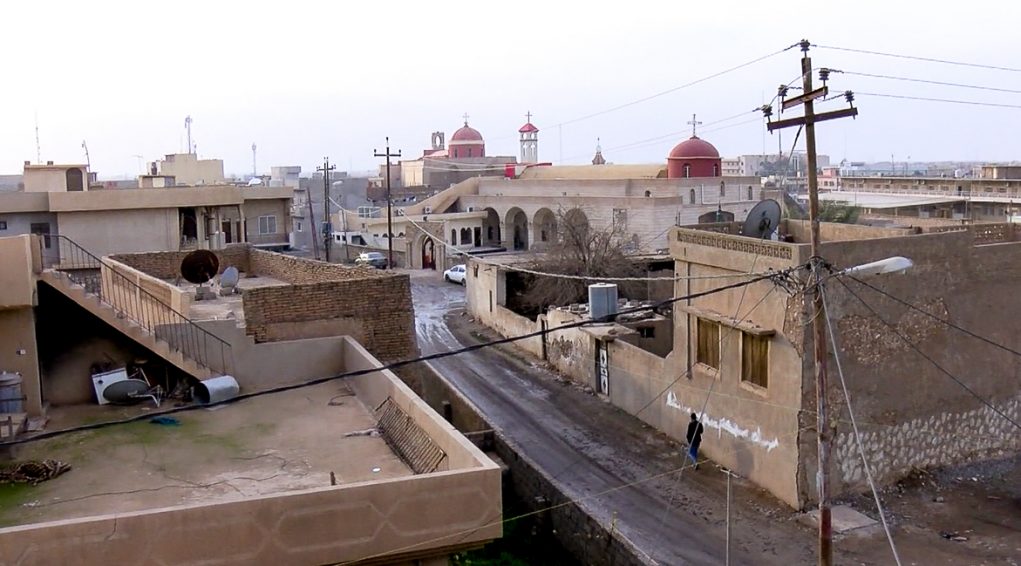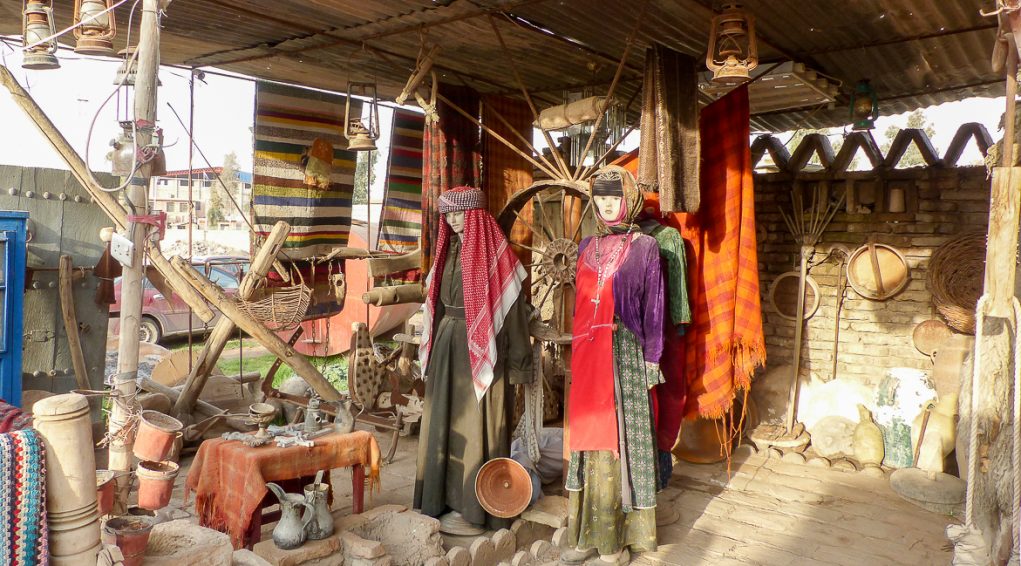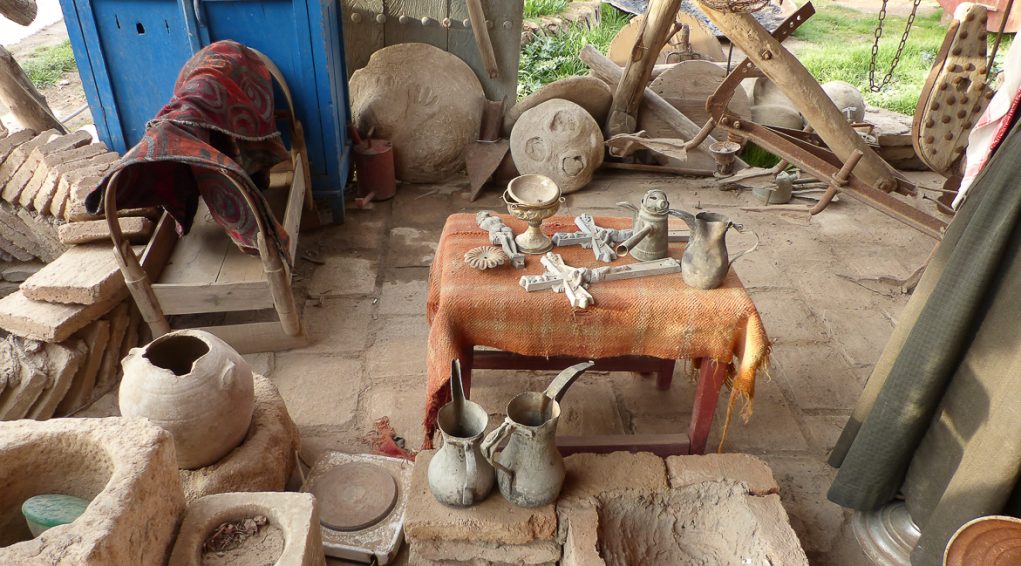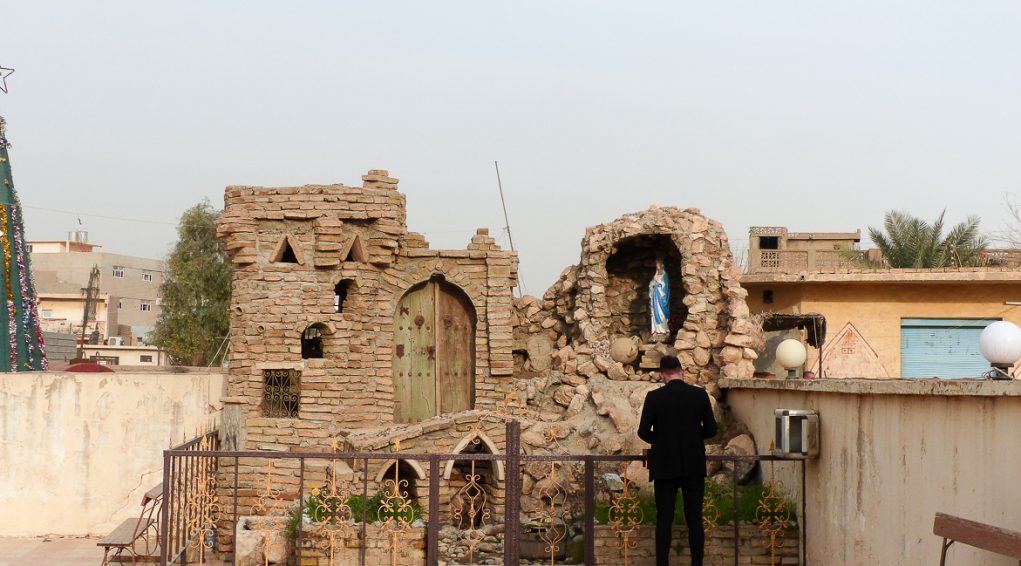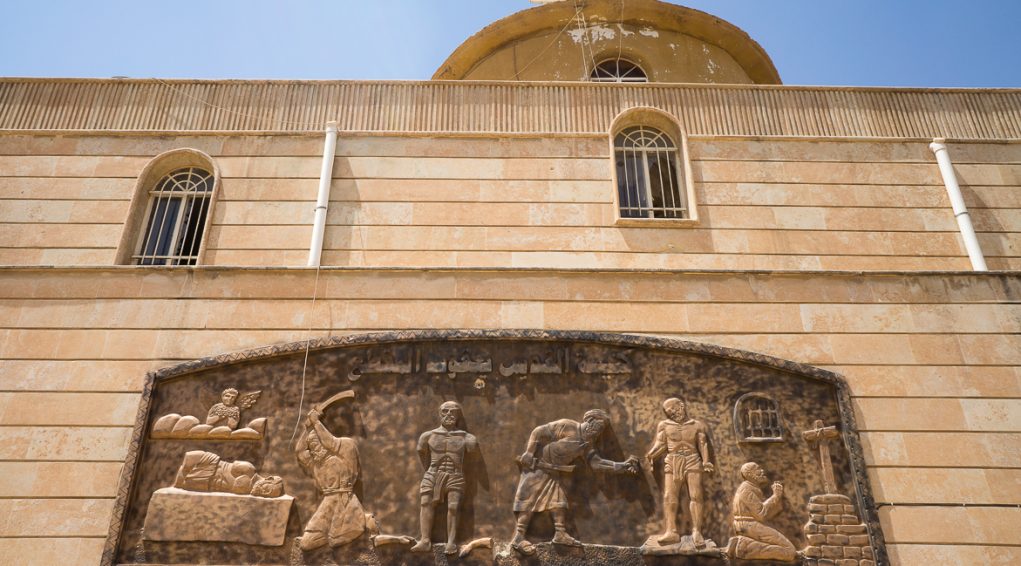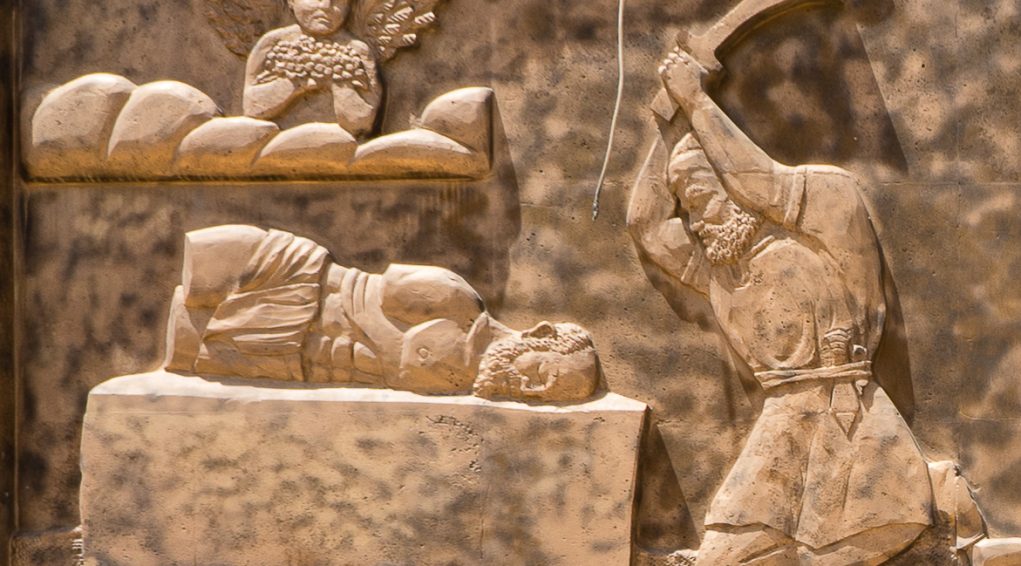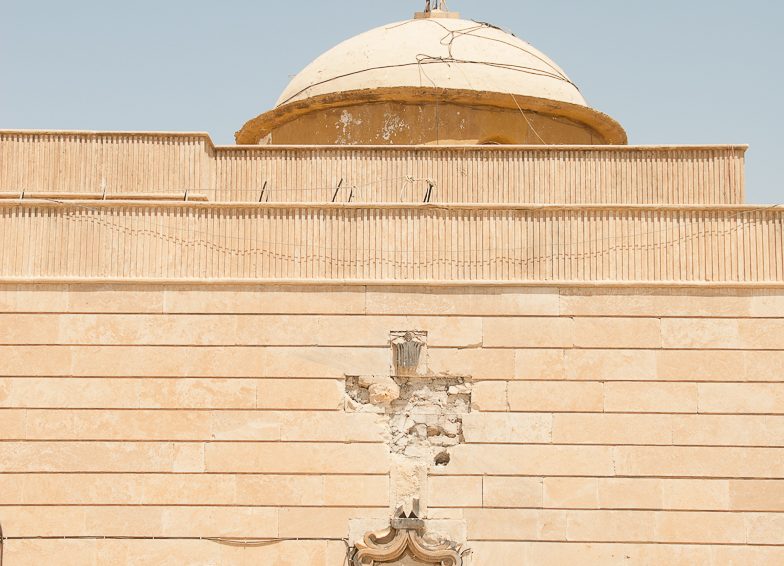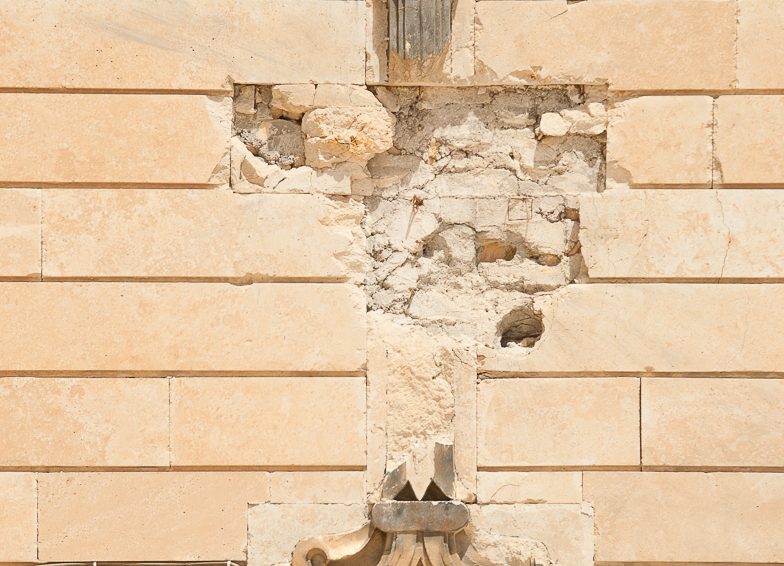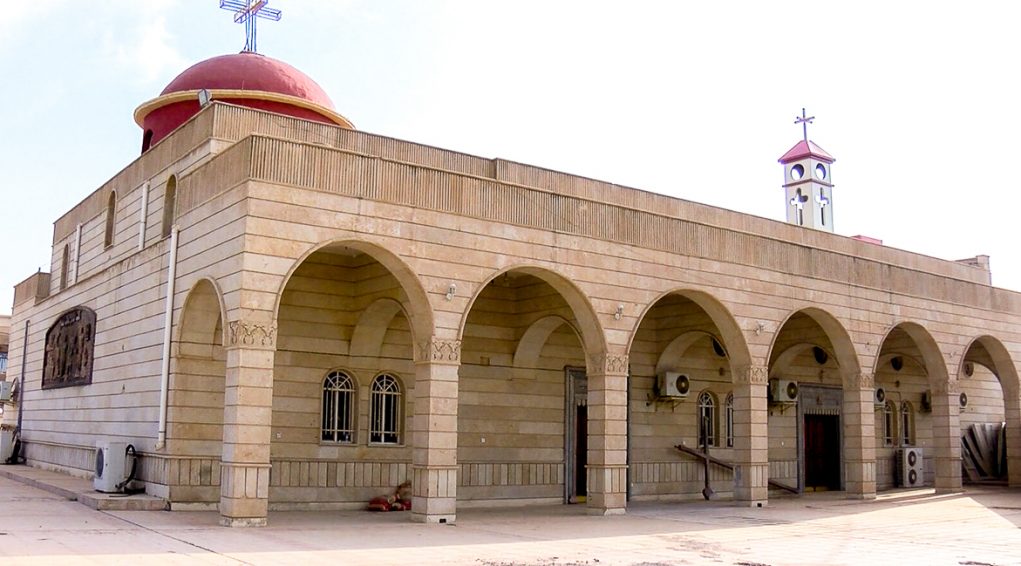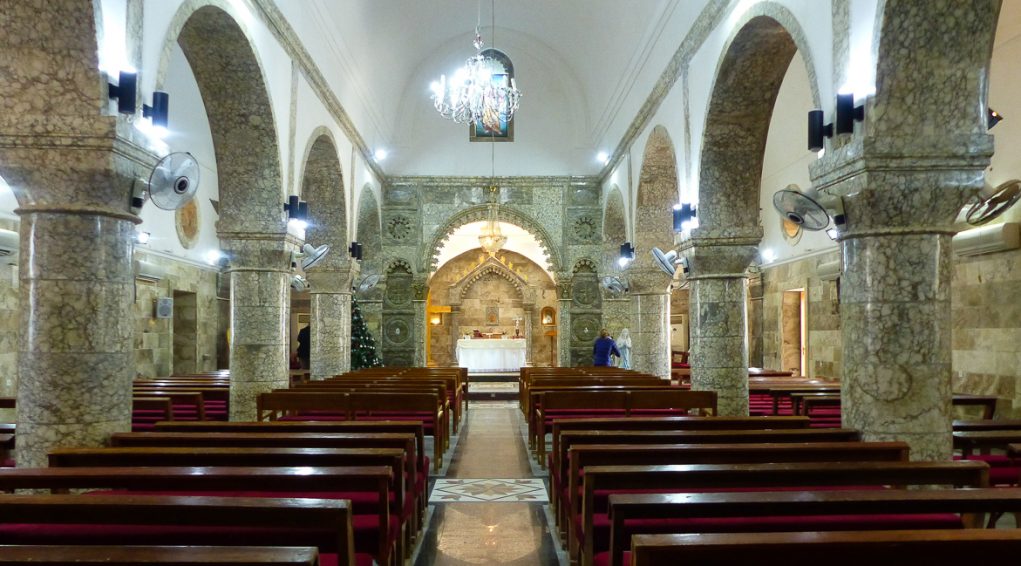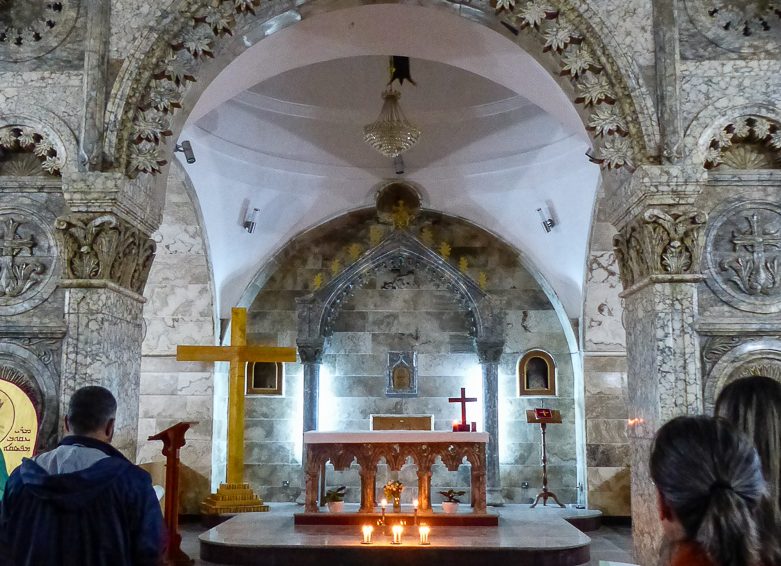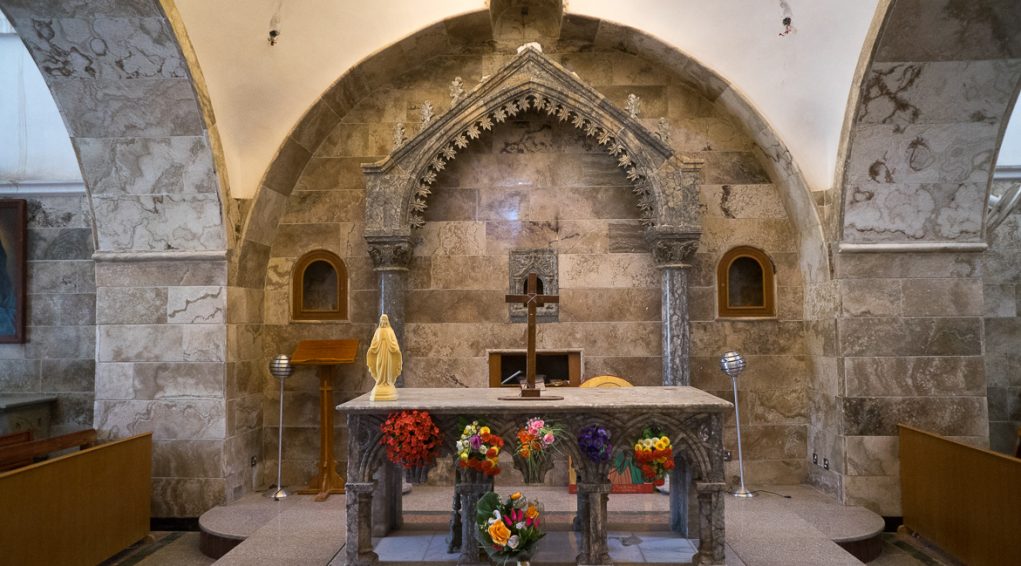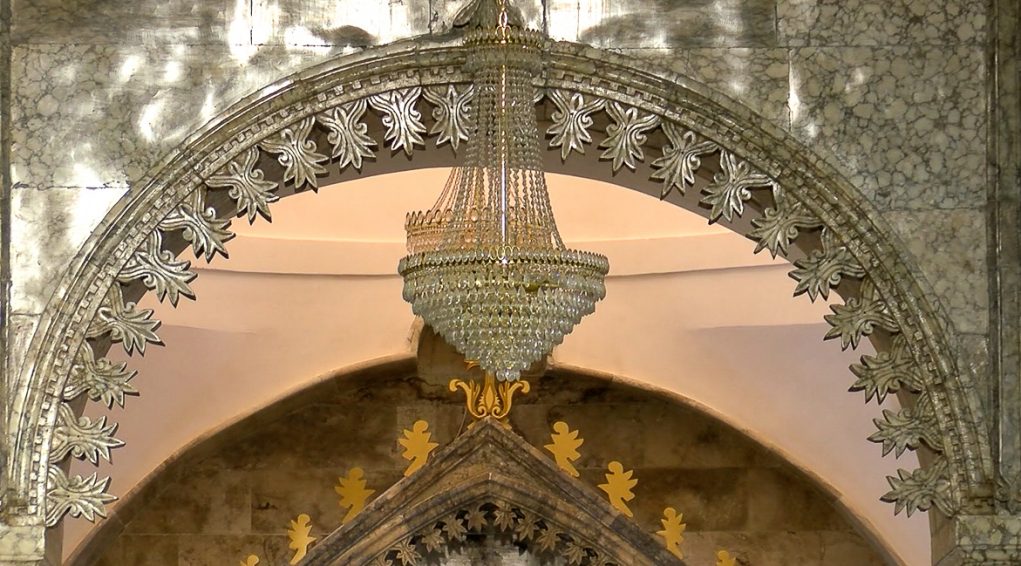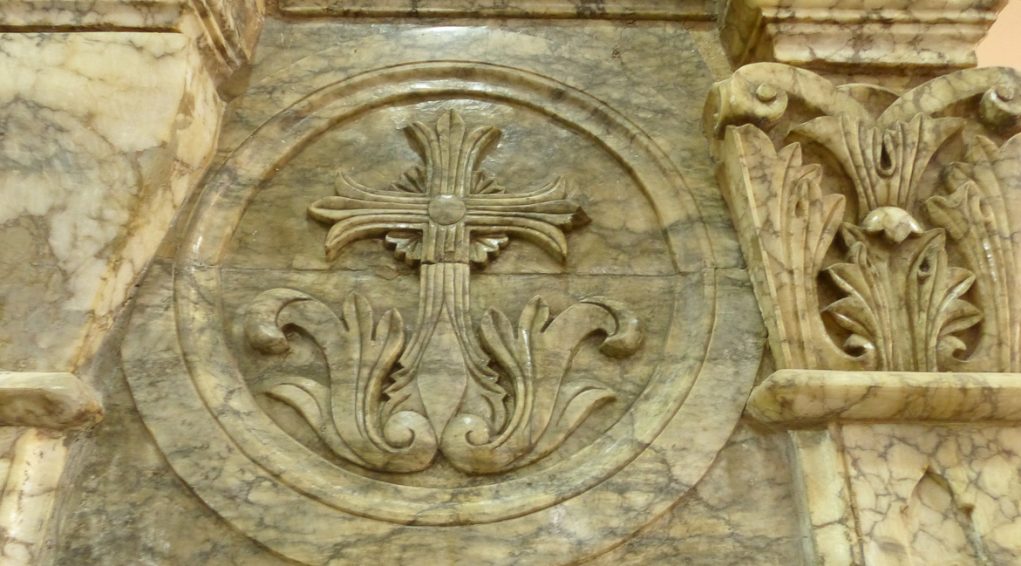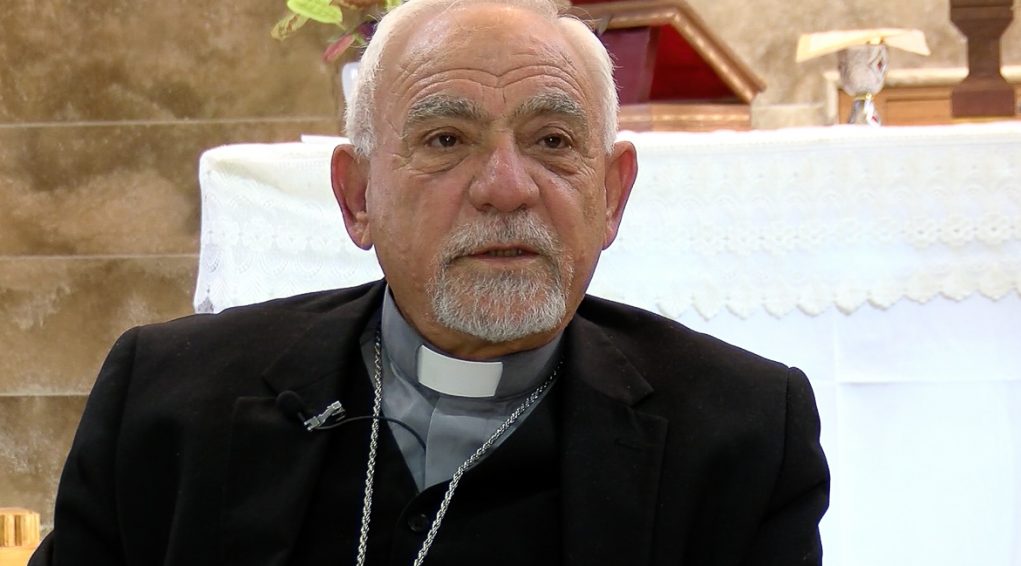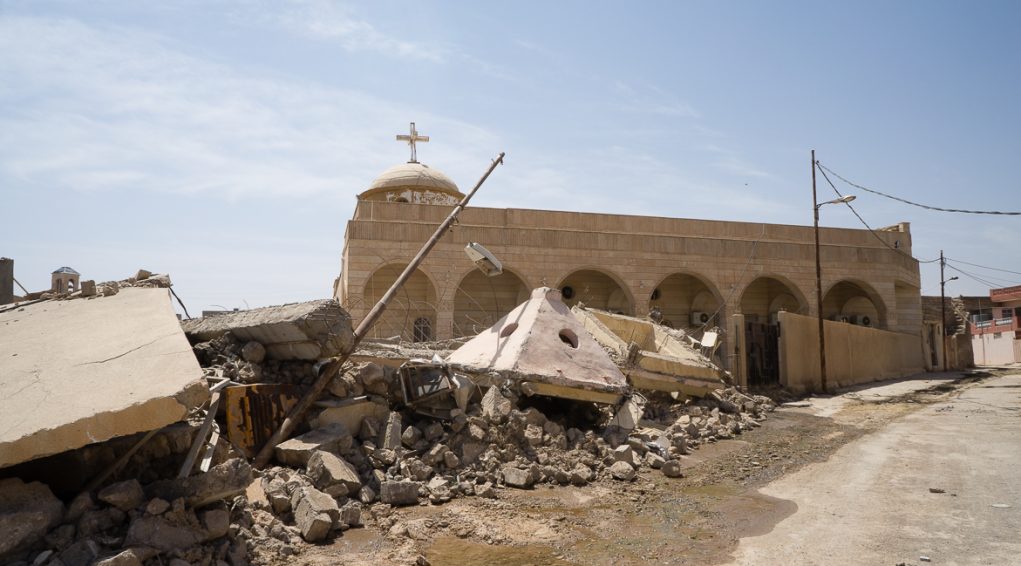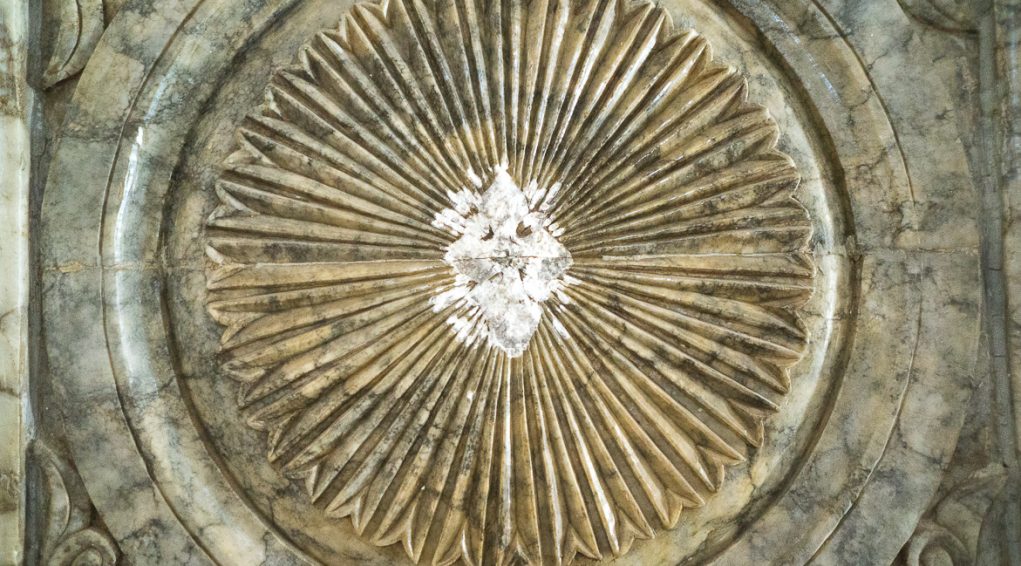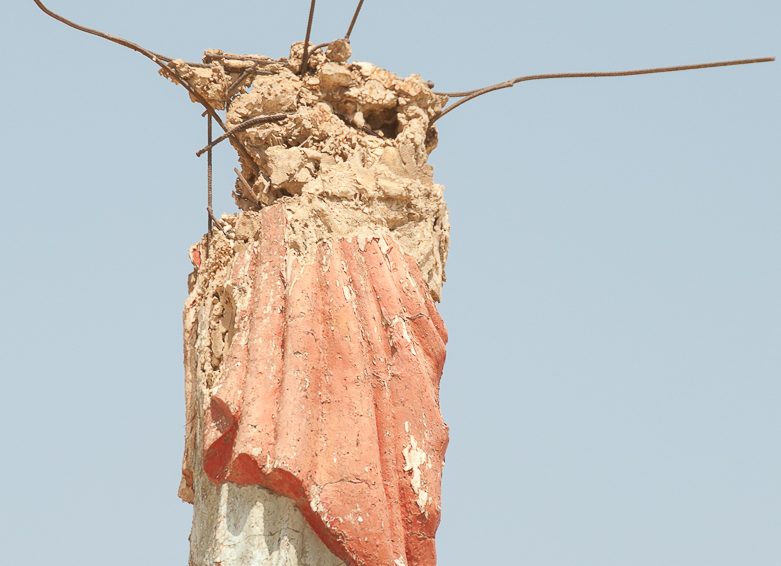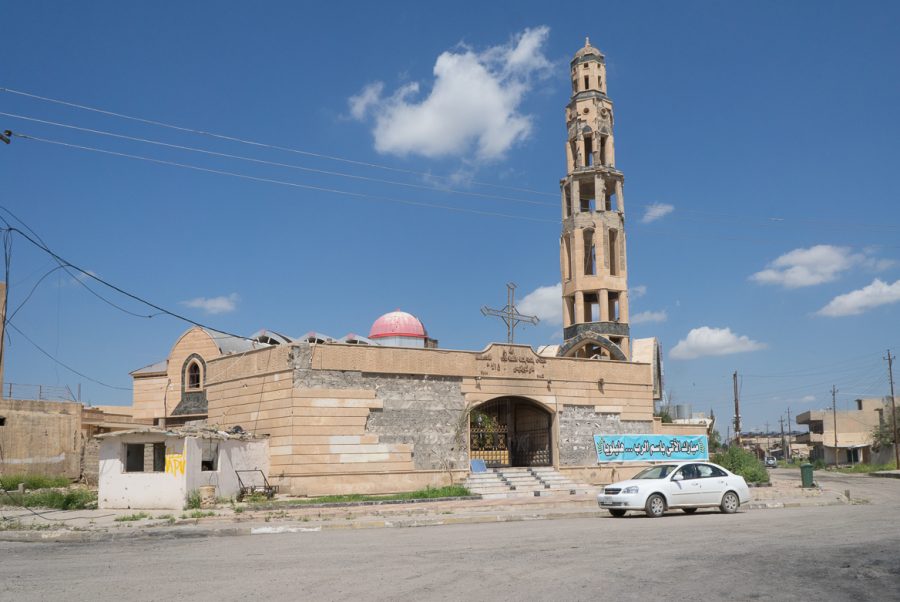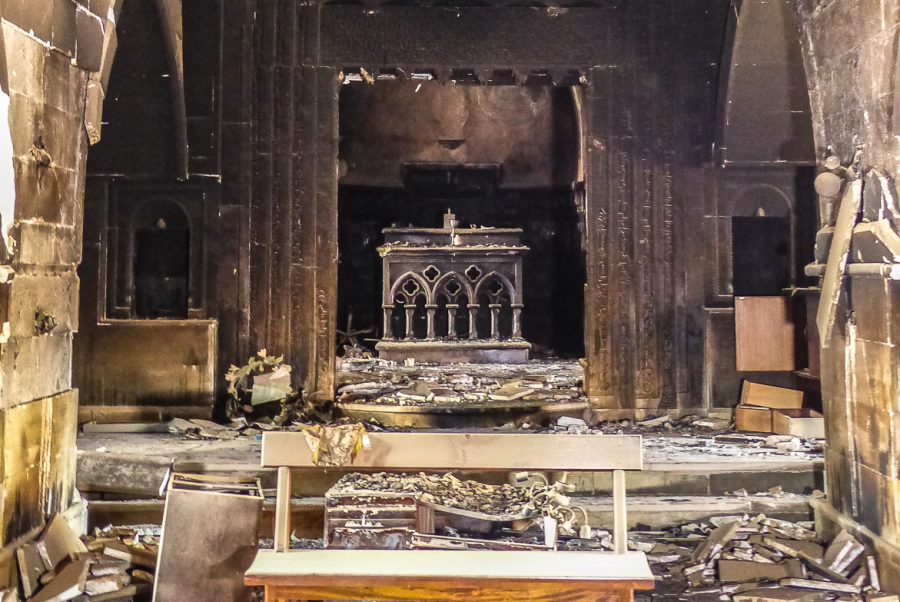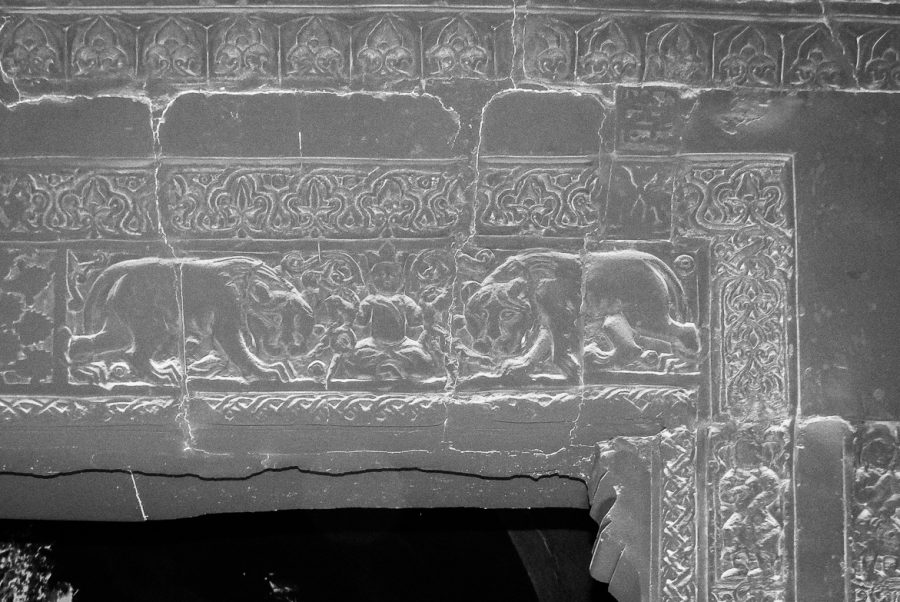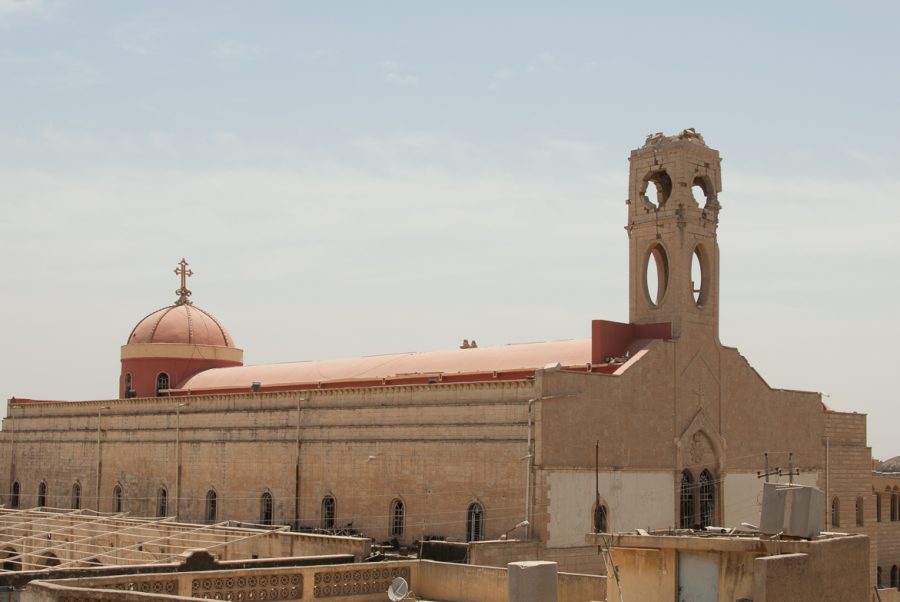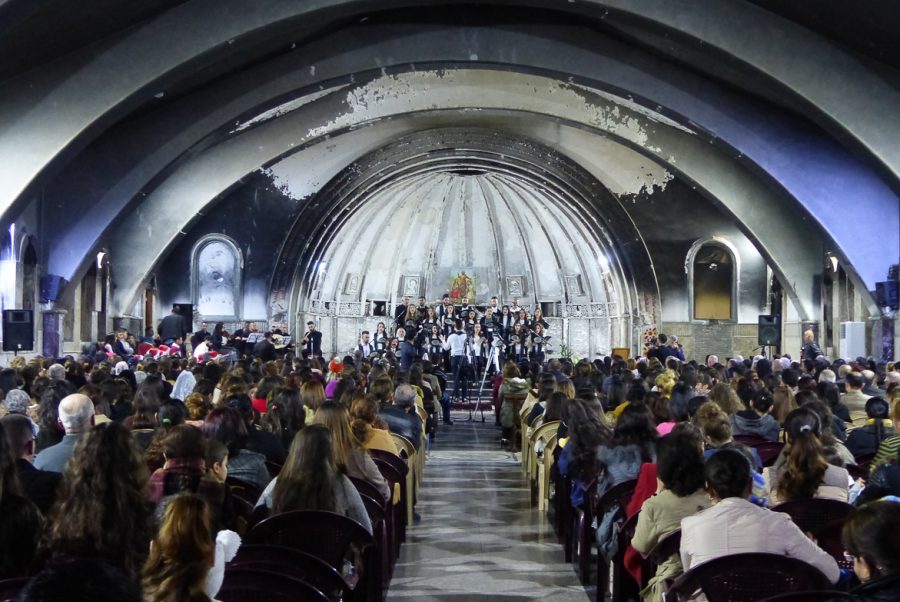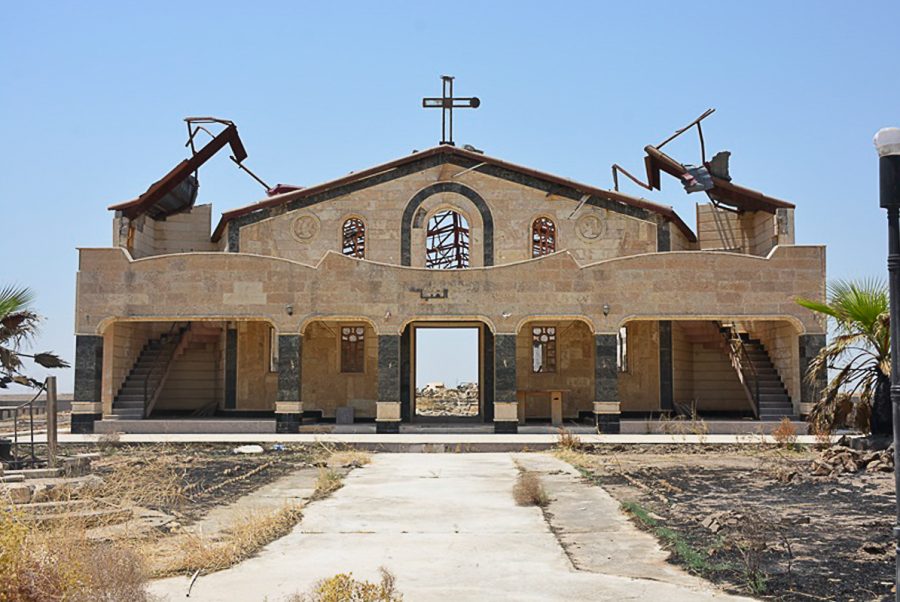The Saint James the Mutilated (Mar Yacoub Al-Muqataa) Syriac-Catholic Church in Baghdede (Qaraqosh)
The Mar Yacoub al Mouqataa Syriac-Catholic church is located at 36°16’14.47″N, 43°22’45.54″E and 275 metres’ altitude in the city of Baghdede (Qaraqosh). Known as the church of Mar Yacoub al Mouqataa, the church is actually dedicated to two saints and therefore has two names. It is consecrated to both Saint James the Mutilated (Saint James Intercisus) and Saint Andrew the Apostle.
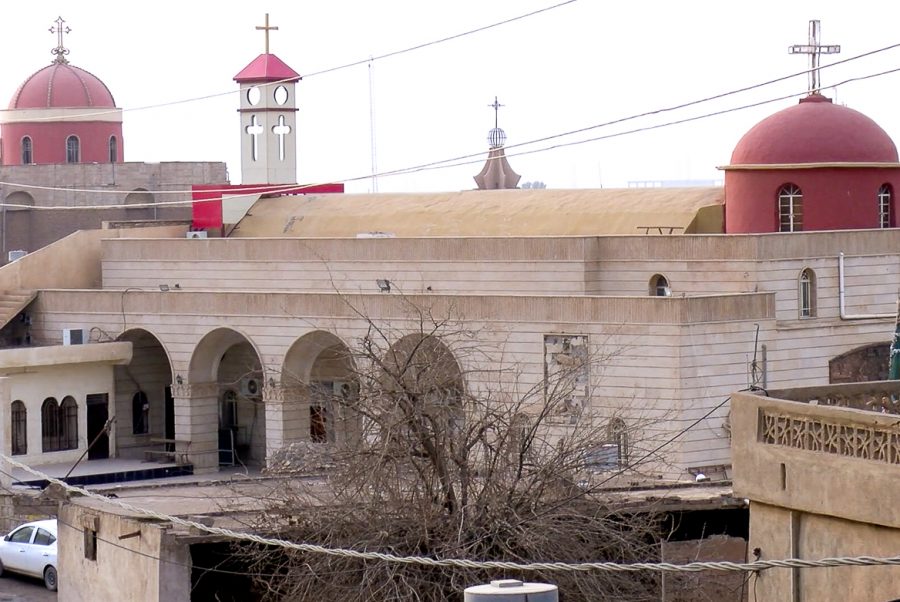
The Mar Yacoub al Mouqataa church is attested to in a manuscript dating from 1712. In 1743 it was destroyed by the Persian Nâdhir Shâh but was rebuilt in 1744 by the governor of Mosul. In the 18th century it was the first church in Baghdede to be assigned to the Catholic church, after the definitive division of places of worship in 1837. In 1910 the church was razed to the ground to build the existing church. The damage inflicted by ISIS to the interior of the church is less severe than that sustained by other churches in Baghdede.
| Plan of the church of Mar Jacob al Muqataa in Baghdede (Qaraqosh), after Suhayll Qasha, modified, 1982 © « Les églises et monastères du Kurdistan irakien à la veille et au lendemain de l’islam », PhD thesis by Narmen Ali Amen. Saint Quentin en Yvelines University. May 2001, p.201 |
Location
The Mar Yacoub al Muqataa Syriac-Catholic church is located at 36°16’14.47″N, 43°22’45.54″E and 275 metres’ altitude in the city of Baghdede.
At the very heart of the Syriac plain, Baghdede (Qaraqosh) lies 30 km southeast of Mosul and 80 km west of Erbil and is the largest Christian city in the Nineveh plain. It also lies 40 km upstream of the confluence between the Tigris River and the Great Zab.
Previously located in the northern sector of the village of Baghdede, the Mar Yacoub al Muqataa Syriac-Catholic church is now located in the city centre, between the Mar Yohanna and Al-Tahira churches.
Toponomy of Baghdede
The name Qaraqosh, which in modern Turkish means Black Bird, is quite frequently used but its other, original name Baghdede (Baghdeda) in the Syriac language “probably comes from Bet Khudaydad which combines both semitic (Bet) and Persian (Khudaydad) origins [and which] means the place, the house given by God”[1] and this is once again the name most commonly used.
_______
[1] Source Jean-Marie Mérigoux, O.P., in “L’Orient chrétien dans l’empire musulman”, Collection Studia Arabica III, Editions de Paris, 2005.
Fragments of the Christian history of Baghdede
According to the tradition, Christianity reached the Nineveh plain and the city of Baghdede at the end of the 4th century or the beginning of the 5th century. More than likely, sources argue that evangelisation began in the 7th century. “The village was first Nestorian[1], then around 615 [it] became Monophysite[2]. In the 11th and 12th centuries, many Christians from Tikrit, before being forced to convert to Islam, left Tikrit and settled in Baghdede. In 1743, Nader Shah’s troops besieged the area, plundered Baghdede and destroyed the churches. At that time, the villagers escaped to Mosul and took part in the defence of the town.”[3] Former Syriac-Orthodox see of the archbishopric, it was by the end of 18th century that the village became Catholic before the definitive distribution of churches in 1837.
The city of Baghdede still today has several ancient Syriac-Catholic and Orthodox churches. All were violated, sullied, plundered, even burned down by ISIS, throughout the 26 months it occupied the city, from August 2014 to October 2016. Despite the damage and destruction sustained, some of these churches have resisted in the face of the invading forces and the passage of time and testify to a distant past.
Since its liberation, Baghdede (Qaraqosh) has progressively re-kindled its spiritual fervour. With the return of its inhabitants since April 2017, the city has progressively become one of the focal points of the Syriac and Christian revival in the Nineveh plain and Mesopotamia.
_______
[1] Author’s note: Church of the East.
[2] Author’s note: Syriac-Orthodox
[3] Source Jean-Marie Mérigoux, O.P., in “L’Orient chrétien dans l’empire musulman”, Collection Studia Arabica III, Editions de Paris, 2005.
Demography of Baghdede
It is tricky to present reliable statistics regarding the demography of this town (and of the whole country), as censuses are made impossible by successive wars and never-ending mass movements of population. Nevertheless, we can suppose that at least 40,000 to 50,000 people used to live in Baghdede before ISIS attacked. Some probably overestimated statements, made by local residents, mention 70,000 inhabitants.
To these must be added thousands of displaced persons (5,000 to 13,000 depending on the different phases), Christians from Baghdad or Mosul who settled in Baghdede from 2003 on, all running away from crimes and misdemeanours committed by the terrorist and mafia groups that appeared after the Iraqi state collapsed and for whom great efforts had been provided with the aim of a long-lasting settlement.
Whatever the reality of demographical data, nearly 90% of the inhabitants in Baghdede were Syriac-Catholics. The remaining population was divided into Syriac-Orthodox, Chaldeans (Catholics), and a small Armenian Apostolic community.
The city, known for having been exclusively Christian before 1980, was home to around 1,300 Syriac-Catholic families in the 1960s alongside a Syriac-Orthodox minority.[1] Over time dozens of Muslim families arrived in the city as a result of Saddam Hussein’s policy to Arabize the Nineveh Plain.
_______
[1] According to Monsignor Ephrem Abdal, quoted by Jean-Maurice Fiey, in Assyrie Chrétienne, vol.II, p.445-446.
About Mar Yacoub al Muqataa
Saint James the Mutilated (Mar Yacoub al Muqataa) was alive in the 5th century and martyred towards 421. A high-ranking Persian officer in the town of Beth-Lafat (or Beth Lapeta), converted to Christianity, he renounced his faith in front of the Persian Sassinid King Yazdegerd I (also as Izdigerdes, Yesdegird or Yezdajat). Like the apostle Peter, this initial renouncement became the foundation on which his faith was built. Condemned by his mother and his wife, James subsequently repented. The tradition tells us that two years after the death of Yazdegerd, he came before his son and successor Vahram V (also known as Bahram) to proclaim his faith. His punishment was severe and torturous as he was literally and slowly cut into pieces, 28 in total, from his fingers to his head. His hagiography recounts in great detail, part after part, the incredible dialogue between the martyr and his executioners. Saint James the Mutilated is celebrated on 27th November and his story has been told in a song.
History of the Mar Yacoub al Muqataa church in Baghdede (Qaraqosh)
The date of the foundation of the Mar Yacoub al Muqataa Syriac-Catholic church is unknown. The tradition recounts that there was a small chapel on the current site of the Saint James church, dedicated to Saint Andrew the apostle, as of the 13th century. Considered to be very ancient, the Mar Yacoub al Muqataa Syriac-Catholic church is attested to in a manuscript dating from 1712.[1]
The church was left in ruins in 1743 after the troops of the Persian Nâdhir Shâh pillaged the village and the region, destroying all churches. It was rebuilt in 1744 by the governor of Mosul.
As some of the Christians in Baghdede became Catholic in the 18th century, they needed a church to worship in. Hassan Pacha, governor of Mosul, gave them the Mar Yacoub al Muqataa church.
The Syriac-Catholic Mar Yacoub Muqataa church in Baghdede therefore has “special value for Catholics as it was the first church dedicated to their use”[2] before the definitive division of places of worship.
Catholicism developed so significantly that the Mar Yacoub al Muqataa church had to be extended. The solution found in 1910 was a radical one. The ancient church was destroyed and the present-day building built on the same site.
The Mar Yacoub Muqataa religious estate also appears to have been a monastery[3], including up until recent times, with a girls school composed of seven classes, built in 1935 and administered by the Dominican Sisters. This school has since been destroyed and a large school for 300 pupils has been built in the neighbourhood. It was at this time that the decision was made to build the bell tower.
_______
[1] In “Assyrie chrétienne”, vol.II, Jean-Maurice Fiey, p.454
[2] In “Assyrie chrétienne”, vol.II, Jean-Maurice Fiey, p.454
[3] On this subject, Jean-Maurice Fiey cites Monsignor Ephrem Abdāl, superior of the Mar Behnam monastery, born in Baghdede (Qaraqosh), who refers to this in his account of the history of his home city.
Description of the Mar Yacoub al Muqataa church in Baghdede (Qaraqosh)
It is very difficult to know what the ancient Mar Yacoub al Muqataa church in Baghdede looked like, as nothing was kept when the modern church was built, as discovered by the Dominican scholar Jean-Maurice Fiey in his time. Since this time the modern church has been renovated again.
Like almost all the churches in Baghdede, at the end of the 20th century the building was covered with ochre and beige stone facing. Viewed from the outside, the building is imposing in stature. To the east it is mounted with a drum dome above the chevet.
Inside, the Mar Yacoub al Muqataa church has a basilica-shaped floor plan with three naves and five bays, characteristic of the sacred architecture of western Syrian churches (Syriac-Orthodox and Syriac-Catholic). At the far end of the nave, mounted with a barrel vault, the choir platform reserved for the clergy can be accessed before entering the sanctuary. The Holy of Holies (the sanctuary), facing east, is made up of three parts. The high altar stands in the centre of the chevet. Formerly adjoining the apse chapel, preceded by a stone arch, it was moved forward at the end of the 1980s to allow the celebrant to face the congregation. Its arch was placed against the wall.
Above the chevet stands the dome. Originally windowless, it was fitted with small, round windows, placed high up, apparently to avoid theft and pillage. In 1983, Father Yousif Abba (Syriac-Catholic archbishop of Baghdad since March 2011) undertook renovation work, notably installing windows to allow the light in. The building was not under threat at this time.
The central sanctuary has open accesses to either side to the side rooms, the martyrion (bēt sōhdē, in Syriac) to the north and the sacristy (bēt diāqōn) to the south. The baptismal font appears to be placed at the entrance to the north side-aisle. The nave and the two side-aisles are separated from the sanctuary by the royal door, in the centre, and two side doors. The doors and arches are made of Mosul grey marble. The sculptures which adorn the royal door are richly decorated and finely sculpted with acanthus leaves and other flowered crosses, as was the arch which enhances and embellishes the high altar.
To the left of the first entrance door on the right-hand side are the relics of Mar Gabriel, a regional saint. Found during the work done to the Al-Tahira church, these relics were gifted to the Saint James church by Monsignor Georgis Jalla. They are embedded into the wall and impossible for neophytes to locate.
In 1984, Father Noel Qas Tom (current chorbishop of the Al-Tahira church) was named archbishop. During the 18-year period he was responsible for the church he undertook extensive work. In the courtyard of the church where the cemetery and school used to be located, he had a room built for parish activities and wakes. The corpses of the people buried in the cemetery were transported to the outskirts of the city.
Inside the church, he built a tribune for the choir.
He also had a statue of Christ the King that was in the courtyard moved to the roof of the church. This statue was destroyed by the jihadists, along with the bell tower.
Finally, Abouna Noël Qas Toma founded two “Faith and Charity” groups the Iraqi equivalent of the movement initiated by Jean Vanier in France “Faith and Light”.
News of the Mar Yacoub al Muqataa church in Baghdede (Qaraqosh)
The damage inflicted by ISIS to the interior of the church is relatively less severe than that sustained by other churches in Baghdede. However, outside of the church some of the additional facilities were dynamited.
A new bell tower was built in October 2017.
Monument's gallery
Monuments
Nearby
Help us preserve the monuments' memory
Family pictures, videos, records, share your documents to make the site live!
I contribute